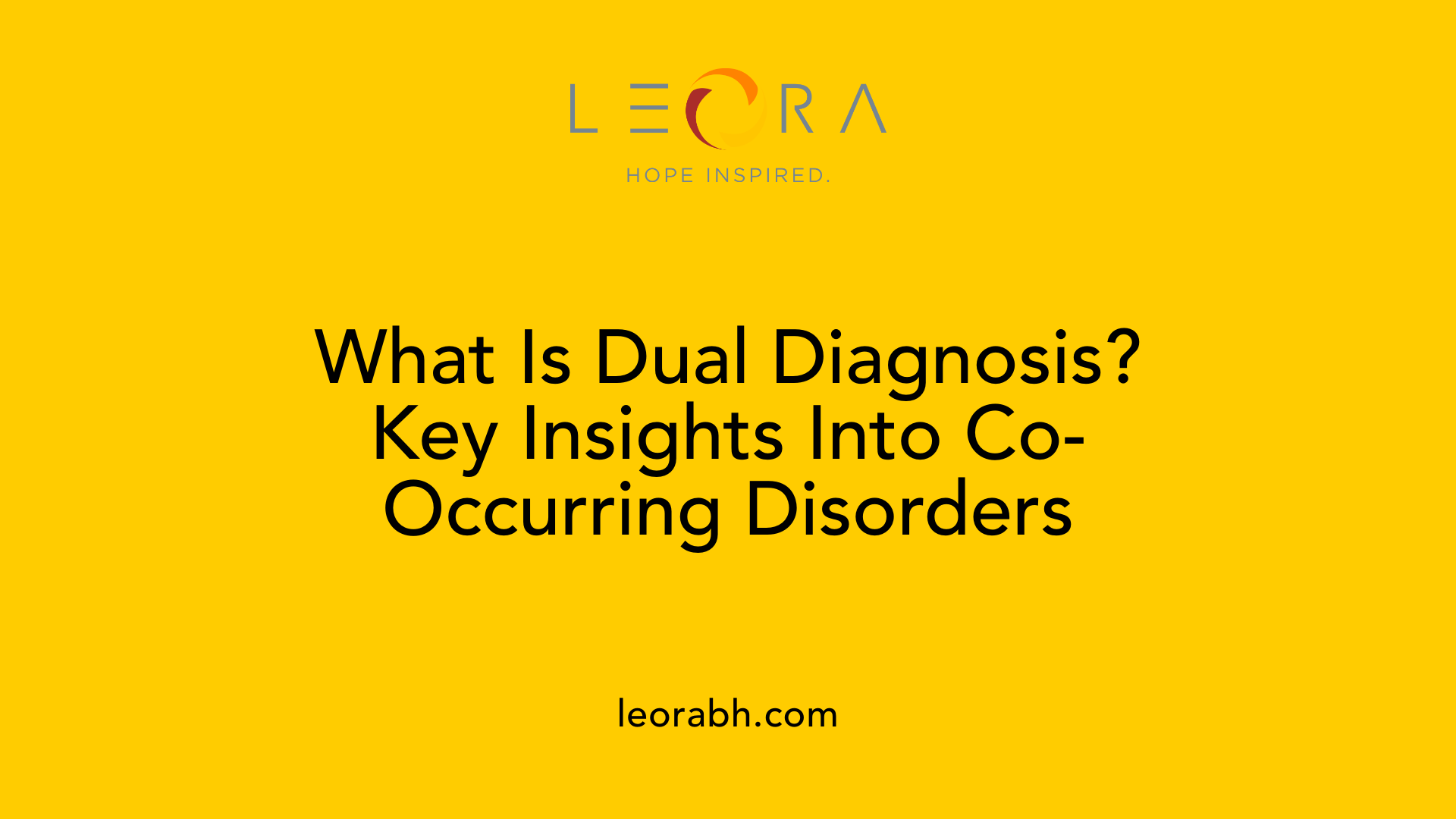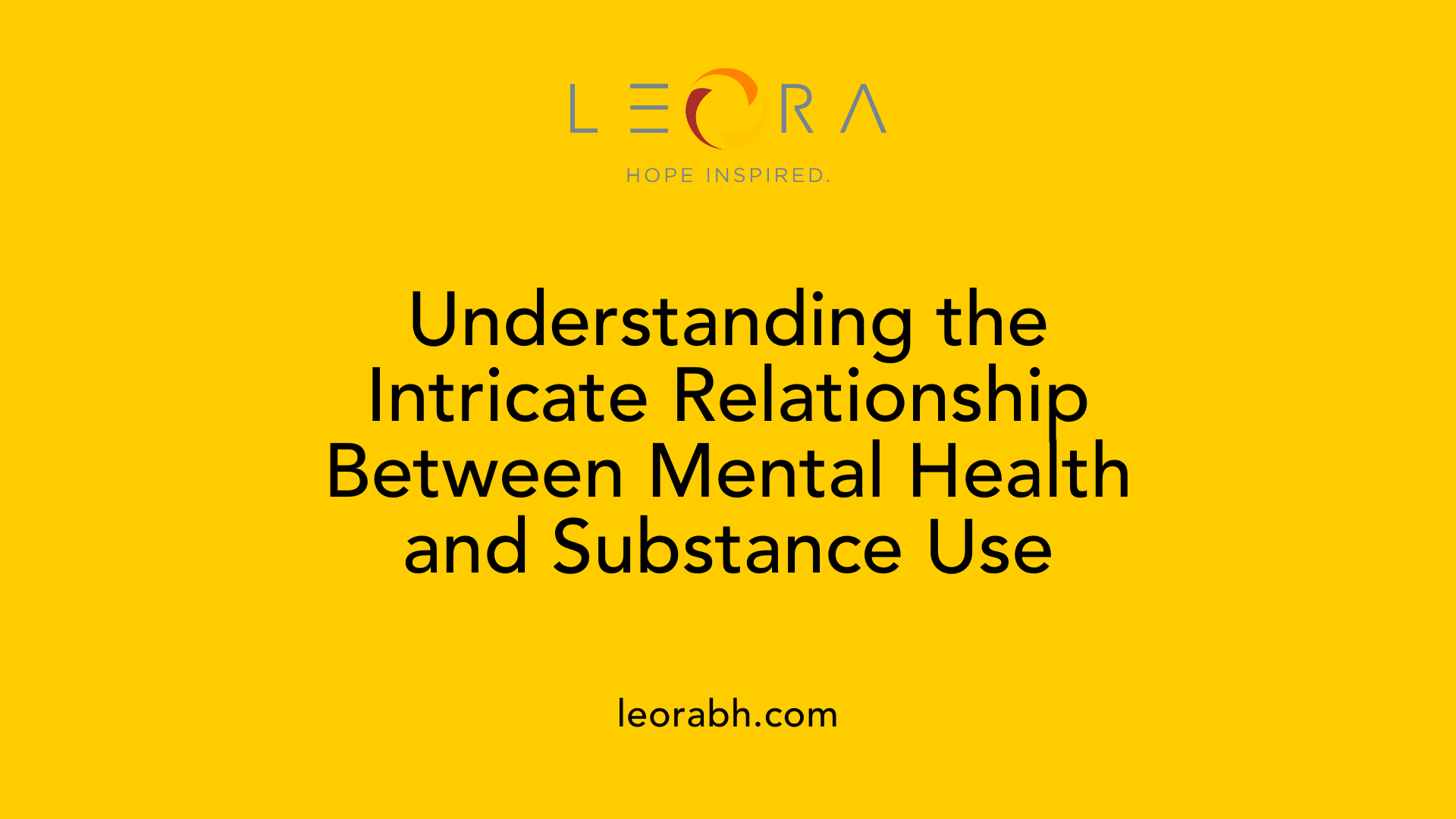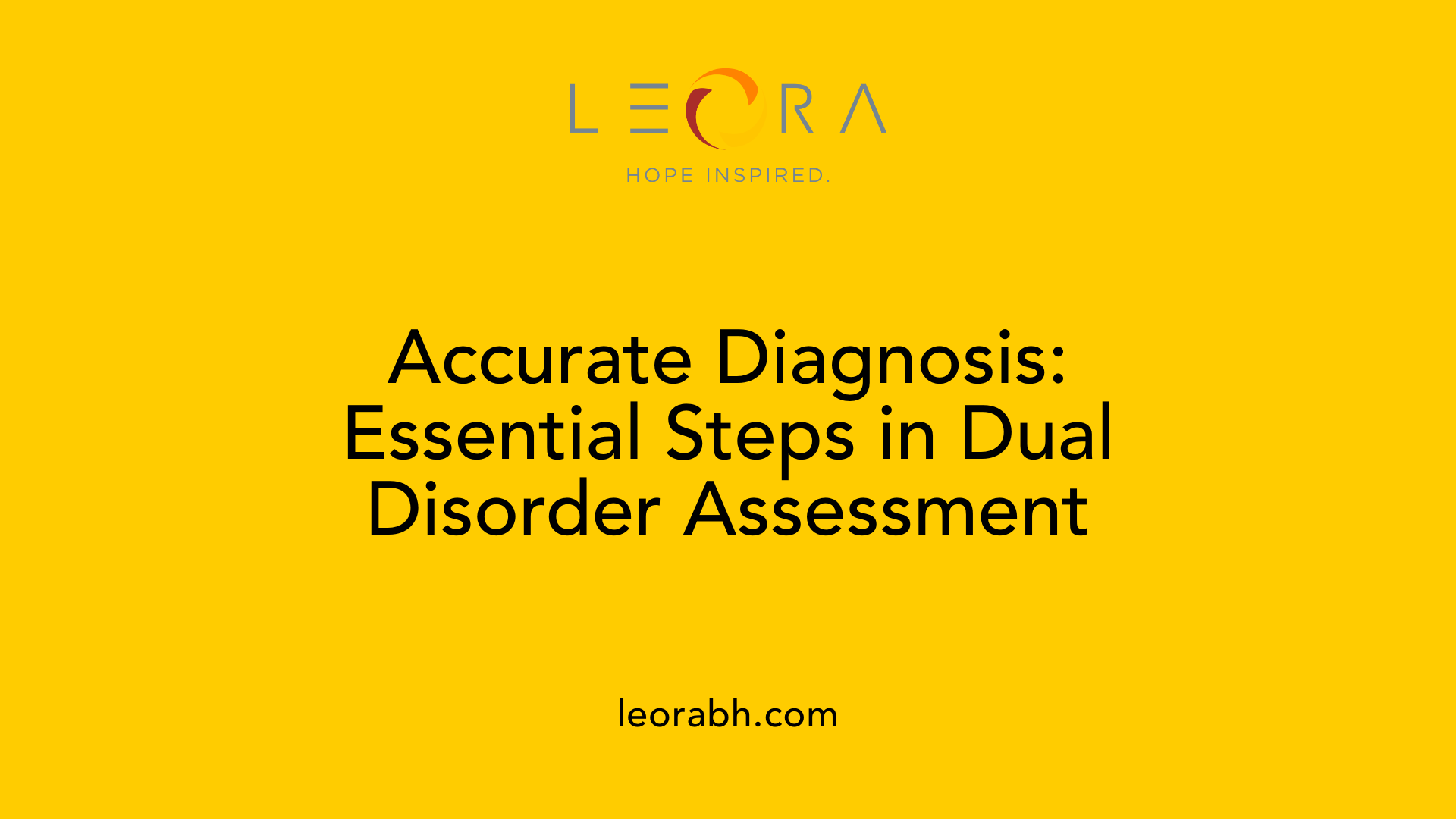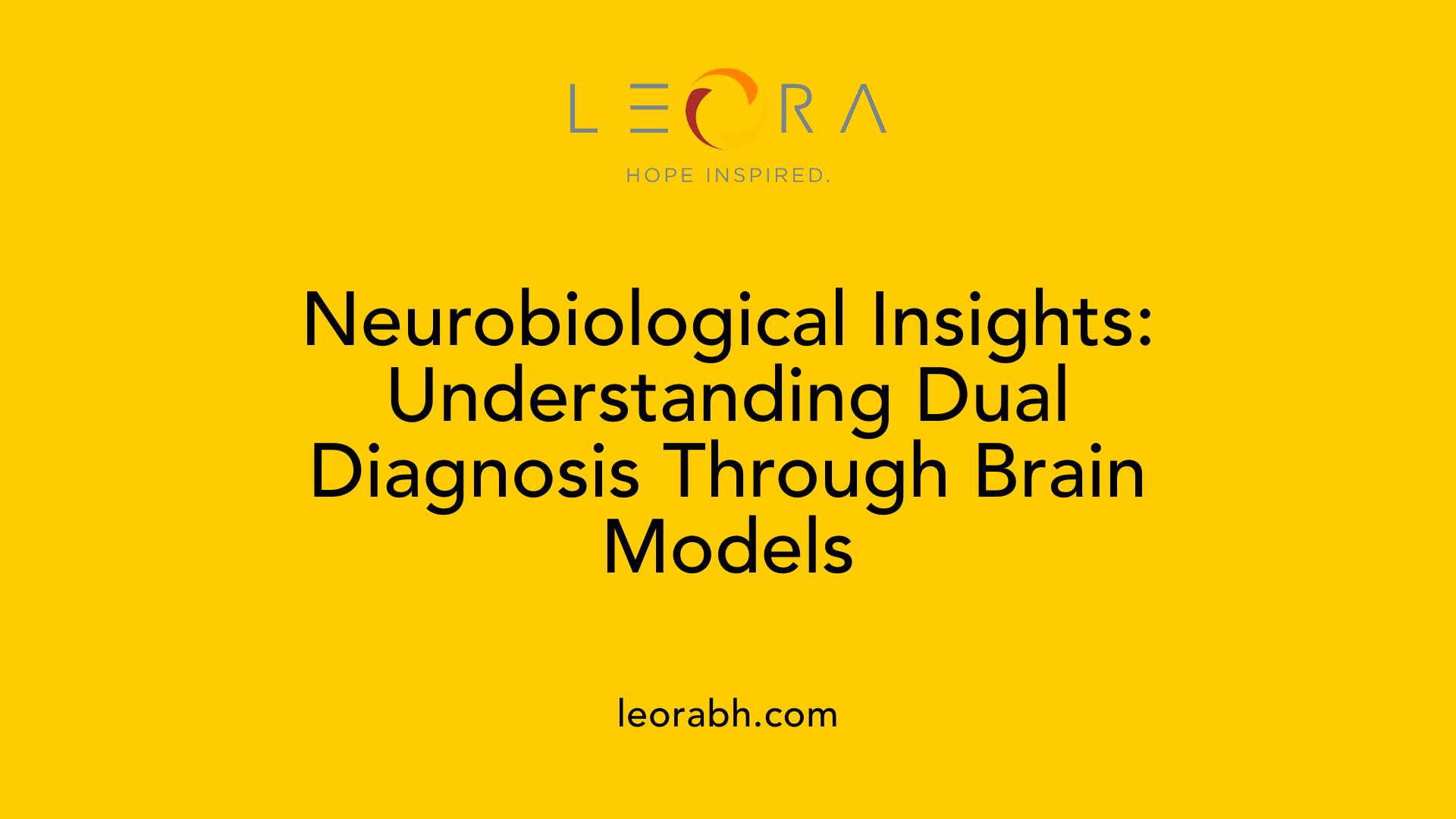Understanding Dual Diagnosis: Mental Health and Addiction
Holistic Perspectives and Advances in Addressing Co-Occurring Disorders
An Introduction to Dual Diagnosis
Dual diagnosis, also known as co-occurring disorder, refers to the simultaneous presence of a mental health disorder and a substance use disorder in an individual. Recognized as a complex and multifaceted condition, dual diagnosis affects a significant portion of the population, with approximately 50% of people with one disorder experiencing the other. Understanding this intersection is essential for developing effective treatment strategies tailored to the intertwined nature of mental health and addiction, ultimately improving recovery outcomes.
Defining Dual Diagnosis and Its Significance

What is dual diagnosis in mental health?
Dual diagnosis in mental health refers to the simultaneous occurrence of a mental health disorder and a substance use disorder in an individual. This condition, also known as co-occurring disorder or co-morbidity, involves coexistence of psychiatric issues such as depression, anxiety, bipolar disorder, or schizophrenia alongside addictive behaviors related to alcohol, drugs, or other substances.
The relationship between the mental health disorder and substance use is often intricate and bidirectional. For instance, untreated mental health issues may lead individuals to self-medicate with substances, while prolonged substance abuse can trigger or worsen mental health symptoms.
Diagnosing dual diagnosis can be complicated because symptoms of each condition can overlap or mask each other. Effective treatment typically requires an integrated approach that concurrently addresses both disorders. This may involve combined therapy, medication management, and ongoing support systems.
Recognizing dual diagnosis is vital, as untreated dual conditions can lead to increased risk of relapse, hospitalization, legal issues, and social problems. Managing these conditions together improves the chances of recovery, enhances quality of life, and reduces the risk of adverse outcomes.
What is a dual diagnosis in mental health and substance use?
A dual diagnosis specifically refers to the coexistence of a mental health disorder and a substance use disorder within the same person. For example, someone suffering from depression or anxiety may also struggle with alcohol dependence or drug addiction.
This condition is quite common; research indicates that about 50% of individuals with a mental health disorder also have a substance use disorder, and vice versa. The interaction between these two conditions can be complex. Mental health issues might lead individuals to use substances as a form of self-medication, while substance use can precipitate or intensify mental health symptoms.
Shared risk factors such as trauma, genetic predispositions, and environmental influences contribute to the high prevalence of dual diagnosis. Effective treatment involves an integrated, holistic strategy that targets both conditions simultaneously through psychotherapy, medication, support groups, and tailored interventions.
Addressing dual diagnosis is essential for reducing relapse rates, preventing worsening of health, and promoting sustained recovery, making it a critical focus within mental health and addiction services.
The Complex Link Between Mental Health Disorders and Substance Use

How do behavioral addictions relate to co-occurring disorders?
Behavioral addictions, such as gambling, sex, shopping, eating, and pornography, involve compulsive behaviors that activate the brain’s pleasure centers, similar to the effects of substances like drugs and alcohol. These process addictions can develop alongside substance use issues, leading to co-occurring disorders that complicate treatment.
Individuals with behavioral and substance addictions often experience overlapping symptoms, such as cravings, mood swings, and impulsivity, which can make diagnosis and intervention more challenging. The shared pathways in the brain’s reward system mean that both types of dependencies can reinforce each other, increasing the difficulty of recovery.
Effective treatment requires a comprehensive approach that addresses both the behavioral addiction and substance use disorder simultaneously. Personalized therapy plans may include cognitive-behavioral therapy (CBT), support groups, and sometimes medication, aiming to modify compulsive behaviors and manage cravings. Recognizing the link between behavioral dependencies and dual diagnoses underscores the importance of integrated care to promote better outcomes.
Understanding these connections highlights that managing one issue without addressing the other often leads to higher relapse rates. Therefore, clinicians emphasize the need for strategies that treat the whole person, supporting long-term recovery and improved mental health.
What are common examples of dual diagnosis?
Common examples of dual diagnosis involve various combinations of mental health disorders and substance use problems. Some typical cases include:
- Depression paired with alcohol dependence
- Anxiety disorders with drug abuse
- Bipolar disorder and cocaine addiction
- Post-traumatic stress disorder (PTSD) alongside opioid misuse
- Schizophrenia combined with methamphetamine-induced psychosis
- Mental illnesses along with cannabis or prescription drug misuse
These dual issues often arise due to shared risk factors such as genetic predisposition, trauma, stress, or early exposure to substances. Many individuals use substances as a form of self-medication to cope with psychiatric symptoms, which can lead to dependency and worsened mental health.
Treatment strategies generally involve simultaneous management of both conditions through integrated approaches. This includes behavioral therapies like CBT and dialectical behavior therapy (DBT), medication, and participation in support groups such as Alcoholics Anonymous (AA) or Narcotics Anonymous (NA). Recognizing these common combinations assists healthcare providers in designing effective, targeted interventions to improve overall well-being.
In conclusion, understanding the typical dual diagnosis scenarios helps foster early detection and comprehensive treatment, ultimately reducing the risk of relapse and supporting sustained recovery for individuals affected by both mental health and substance use disorders.
Prevalence and Impact of Dual Diagnosis
What are the statistics and epidemiology of dual diagnosis?
Dual diagnosis, also called co-occurring disorders, is increasingly recognized as a common health concern. In the United States, approximately 17 million adults—a significant portion of the population—have experienced both a mental health disorder and a substance use disorder in 2020 alone. Statistically, about 50% of individuals with a mental illness also grapple with substance abuse issues, and similarly, half of those with substance use problems have mental health conditions.
Research indicates that over 21 million Americans suffer from a substance use disorder, with around 8 million of them also diagnosed with a mental health issue. Common combinations include depression with alcoholism, anxiety disorders with prescription drug abuse, and bipolar disorder with stimulant misuse.
The American prevalence rates reflect global patterns, with similar trends reported in Canada and other countries, where individuals with mental illnesses are twice as likely to have substance use issues. Young individuals and those with severe mental illnesses tend to have higher rates of co-occurrence.
What are the implications for individuals and society?
For individuals, dual diagnosis often results in complicated health trajectories. These individuals are at increased risk for relapse, hospitalization, homelessness, social isolation, and legal issues. They also face higher mortality rates, including from overdose and suicide.
Society bears substantial burdens from dual diagnosis. The healthcare system experiences increased costs due to repeated hospital stays, emergency interventions, and ongoing treatment needs. Furthermore, untreated dual diagnosis can lead to high rates of unemployment, criminal justice involvement, and transmission of infectious diseases such as HIV and hepatitis.
The complex interplay of mental health and substance use can hinder personal development and community integration. Untreated or inadequately treated dual diagnosis populations are more likely to experience chronic health problems, adding to societal expenses.
What are the challenges associated with dual diagnosis?
The challenges associated with dual diagnosis include the complexity of accurately diagnosing co-occurring mental health and substance use disorders, as symptoms often overlap and influence each other. Managing both conditions simultaneously requires integrated treatment approaches, yet many healthcare systems remain fragmented, leading to gaps in care and inadequate support.
Patients with dual diagnosis tend to experience higher levels of disability, homelessness, legal issues, and longer hospitalizations, increasing their vulnerability and societal marginalization. Additionally, stigma, limited resources, and barriers to accessing comprehensive, coordinated care hinder effective treatment and recovery efforts.
Overall, addressing dual diagnosis necessitates specialized, holistic approaches that consider the interplay of mental health and substance use issues to improve outcomes.
What treatment options are available for managing dual diagnosis?
Effective management of dual diagnosis involves an integrated, comprehensive plan that addresses both mental health and substance use disorders concurrently. Treatment strategies include:
- Behavioral therapies: Cognitive Behavioral Therapy (CBT), Dialectical Behavioral Therapy (DBT), and Motivational Interviewing are tailored to support individuals in managing symptoms and developing healthier behaviors.
- Medication: Prescribed medications target mental health symptoms and cravings, with careful monitoring to minimize drug interactions and misuse.
- Support groups: Peer-led programs such as Alcoholics Anonymous (AA) or Narcotics Anonymous (NA) offer ongoing social support.
- Family involvement: Family therapy helps build supportive home environments.
- Inpatient and outpatient programs: Structured detoxification and residential treatment centers with specialized dual diagnosis programs provide intensive care.
The goal of these treatments is to promote sobriety, reduce symptoms, prevent relapse, and support long-term recovery. Addressing both disorders simultaneously improves overall functioning and quality of life.
How does integrated treatment improve outcomes?
Integrated treatment ensures that healthcare providers address mental health and substance use issues in a coordinated manner. This approach reduces relapse rates, decreases hospital readmissions, and improves mental and physical health outcomes.
Patients typically show better engagement, adherence to medication, and participation in therapy when both issues are treated together. Such comprehensive care supports stability, helps prevent complications like social and occupational decline, and fosters resilience.
Supporting individuals with dual diagnosis
Supporting loved ones involves understanding their condition, encouraging treatment engagement, and fostering a non-judgmental environment. Education about dual diagnosis, patience, and ongoing support are vital to recovery.
Community resources, including crisis hotlines, outreach programs, and specialized treatment centers, play an essential role in providing accessible, holistic care. Increased awareness and advocacy are crucial for reducing stigma and promoting integrated approaches.
Final insights
In summary, dual diagnosis presents multifaceted challenges for individuals and society but is treatable through integrated, personalized care strategies. Advancements in therapy, medication, and community support continue to improve prognosis. Recognizing the prevalence and societal impact underscores the importance of comprehensive treatment models that address the complex needs of those affected, ultimately fostering healthier communities.
Diagnosis and Assessment of Dual Diagnosis

How is dual diagnosis different from general addiction treatment?
Dual diagnosis, also known as co-occurring disorders, requires a distinct approach compared to general addiction treatment. While traditional addiction programs primarily focus on detoxification and sobriety, dual diagnosis emphasizes the need to evaluate and treat both a mental health disorder and a substance use disorder simultaneously.
In standard addiction treatment, the primary goal is to eliminate substance dependence, often through methods like detox, medication-assisted treatment, and abstinence-focused therapies. However, these programs might overlook underlying mental health issues that contribute to or result from substance use.
Whereas, in dual diagnosis care, treatment providers recognize that mental health problems such as depression, anxiety, bipolar disorder, PTSD, or schizophrenia are intertwined with substance abuse. The presence of both conditions requires an integrated approach that addresses the complex interactions between mental health symptoms and substance use behaviors.
Effective dual diagnosis treatment involves coordinated efforts among psychiatrists, therapists, and addiction specialists. Approaches include psychotherapy—like cognitive-behavioral therapy (CBT) and dialectical behavior therapy (DBT)—medication management for both mental health and addictions, and support in developing healthy coping skills.
Addressing both issues simultaneously has been shown to improve overall treatment outcomes, reduce relapse rates, and help individuals manage their symptoms more effectively over the long term. Without this integrated approach, mental health symptoms may be masked by substance use or worsen once the individual stops using substances, complicating recovery prospects.
Therefore, dual diagnosis treatment differs markedly from general addiction treatment in its scope, strategy, and goals. It recognizes the bidirectional influence of mental health disorders and substance use, aiming to provide comprehensive, personalized care that promotes sustained recovery and improved quality of life.
Screening tools and evaluation strategies
Identifying dual diagnosis begins with thorough screening and assessment. Healthcare providers utilize validated screening tools designed to detect both mental health disorders and substance use issues. These tools include brief questionnaires, symptom checklists, and detailed structured interviews.
Common screening instruments include the Substance Use Disorder Screening Test (SUDST), the Alcohol Use Disorders Identification Test (AUDIT), and the Patient Health Questionnaire (PHQ-9) for depression. For mental health, tools such as the Generalized Anxiety Disorder 7-item scale (GAD-7), the Bipolar Spectrum Diagnostic Scale, and the Mini International Neuropsychiatric Interview (MINI) are frequently used.
The evaluation process involves detailed clinical interviews that explore the individual's history of mental health symptoms, substance use patterns, triggers, behavioral changes, and social functioning. Clinicians also assess the severity of each condition and how they interact.
Because symptoms often overlap between mental disorders and substance use, accurate diagnosis hinges on honest communication and comprehensive assessment. Providers need to differentiate between primary mental health issues and those induced or exacerbated by substance use.
Challenges in diagnosis
Diagnosing dual diagnosis can be complicated due to several factors. Firstly, substance use often masks or mimics psychiatric symptoms, making it difficult to determine which came first or which is primary.
For instance, intoxication or withdrawal can cause mood swings, paranoia, or agitation, which may resemble mental illness. Conversely, untreated mental health disorders can lead to substance use as a form of self-medication.
Secondly, symptoms can fluctuate over time, and comorbidities might evolve, requiring ongoing assessment. Patients may also be reluctant or unable to disclose truthful information about their substance use or mental health symptoms, often due to stigma or fear.
Furthermore, overlapping symptoms such as sleep disturbance, concentration problems, and emotional instability pose diagnostic challenges. It requires skilled clinicians with experience in both psychiatric and addiction medicine to accurately separate and identify co-occurring conditions.
Lastly, limited resources and specialized training in dual diagnosis assessment can impede early and accurate diagnosis, delaying critical intervention.
In sum, an integrated, multidisciplinary approach with validated assessment strategies is essential to accurately diagnose dual diagnosis and develop effective, individualized treatment plans.
Clinical Models and Neuroscientific Perspectives

What are the clinical models of understanding dual diagnosis?
The approaches to understanding dual diagnosis are increasingly centered around neurobiological frameworks that illustrate how brain dysfunctions contribute to the co-occurrence of mental health and substance use disorders. Among these, the most prominent is the neurobiological model based on the impaired response inhibition and salience attribution (iRISA) model.
The iRISA model emphasizes deficits in neural mechanisms responsible for impulse control and assigning importance or salience to stimuli, which are critical in both mental health and substance use conditions. It proposes that in individuals with dual diagnosis, there is a dysregulation in brain circuits that process reward, stress, and cognitive control, leading to maladaptive behaviors like compulsive drug-seeking and neglect of social or health-related cues.
Neuroimaging studies have provided compelling evidence supporting these models. They reveal that addiction impacts six major large-scale brain networks:
| Brain Network | Function | Neural Alterations | Consequences for Behavior |
|---|---|---|---|
| Reward Network | Processing pleasure and reinforcement | Hyperactivity in mesolimbic pathways | Increased craving and drug-seeking behaviors |
| Salience Network | Detecting and filtering crucial stimuli | Dysregulation, heightened response to drug cues | Obsession with substances and increased relapse risk |
| Prefrontal Executive Network | Decision-making and impulse control | Hypoactivity in prefrontal cortex | Poor judgment, impulsivity, difficulty resisting urges |
| Self-directed Network | Self-awareness and introspection | Altered connectivity | Impaired self-regulation and recognition of problem behaviors |
| Habit Network | Behavior repetition and automatisms | Strengthened in addiction pathways | Routines of substance use becoming automatic |
| Memory Network | Learning and contextual memory | Neural plasticity changes | Triggers relapse when exposed to related cues |
These network dysfunctions explain many behavioral features observed in dual diagnosis, such as increased salience for drugs, diminished response to social rewards, and impaired executive function.
Furthermore, these models highlight impairments in core learning processes, especially those governed by top-down neural control. Such neural alterations are correlated with clinical severity, risk of escalation, and treatment responsiveness.
Understanding dual diagnosis through this neurocircuitry lens enables clinicians to adopt more targeted interventions, aiming to modify specific dysfunctional brain circuits. Treatments like neurofeedback, cognitive rehabilitation, and pharmacological agents are being developed to correct these neural imbalances.
Implications for treatment and recovery
Recognizing the neurobiological underpinnings of dual diagnosis has profound implications. It suggests that effective treatment should not only focus on behavioral and psychosocial factors but also incorporate strategies that address underlying brain dysfunction.
Integrated approaches combining medication, psychotherapy, and neurotechnologies aim to restore normal functioning across these networks. For example, pharmacotherapy might target neurotransmitter systems involved in reward and impulse control, while behavioral therapies can enhance top-down regulation.
Additionally, neuroimaging can serve as a biomarker for treatment response, helping tailor interventions to individual neural profiles. As research advances, using neurobiological insights can improve recovery outcomes by fostering a better understanding of the complex brain-behavior relationships in dual diagnosis.
Strategies for Effective Treatment and Support

Comprehensive care approaches
Effective treatment of dual diagnosis requires a coordinated, integrated approach that simultaneously addresses both mental health disorders and substance use issues. This often involves a combination of behavioral therapies, medication management, and support services tailored to each individual’s needs.
Behavioral therapies such as cognitive-behavioral therapy (CBT) and dialectical behavior therapy (DBT) are central to managing symptoms and developing coping skills. These therapies help individuals identify and modify harmful thought patterns and behaviors linked to both mental health and addiction.
Medication-assisted treatment (MAT) can also play a crucial role, especially in managing cravings and stabilizing mental health symptoms. Medications like antidepressants, antipsychotics, and mood stabilizers are often used alongside therapy.
Detoxification is frequently the first step, followed by structured outpatient or inpatient treatment programs that emphasize continuous care. Support groups such as Alcoholics Anonymous (AA) and Narcotics Anonymous (NA), along with specialized dual diagnosis programs, help foster a community of understanding and shared experience.
Long-term recovery success depends on personalized aftercare plans, which include ongoing therapy, medication management, and peer support. These plans help reinforce change and prevent relapse.
Family and community involvement
Family support is vital for recovery. Educating loved ones about dual diagnosis helps them understand the challenges faced by the individual and enables them to offer effective support.
Support strategies involve open communication, setting healthy boundaries, and encouraging treatment adherence without judgment. Family therapy sessions can improve dynamics and strengthen support networks.
Community involvement also enhances recovery prospects. Community services such as outreach programs, mental health advocacy groups, and social services provide additional resources and support.
Peer-led groups and community-based initiatives create environments where individuals can share experiences, learn from others, and build resilience.
Educational programs aimed at reducing stigma and increasing awareness about dual diagnosis also promote societal understanding and support.
Emerging therapies and future directions
Research in mental health and addiction continues to evolve, promising new avenues for dual diagnosis treatment. Emerging therapies such as trauma-informed care, mindfulness-based interventions, and neurofeedback are gaining recognition.
Trauma-focused therapies address underlying trauma often associated with dual diagnosis, helping individuals process past experiences that contribute to their conditions.
Mindfulness-based approaches, including meditation and yoga, help improve emotional regulation and reduce stress, which are critical in managing dual disorders.
Neurofeedback and brain stimulation techniques offer potential in stabilizing brain activity linked to addiction and mental illness.
Future treatment models are moving toward personalized medicine, utilizing genetic and neurobiological assessments to tailor interventions specifically to individual needs.
In addition, technological advances like telehealth expand access to care, offering remote therapy sessions and support groups, especially vital for those in underserved or remote areas.
Investments in research aim to understand better the complex interactions between mental health and substance use, ultimately leading to more effective, holistic treatment options.
| Approach | Description | Benefits |
|---|---|---|
| Integrated Care | Simultaneous treatment of mental health and substance use disorders | Higher recovery rates, reduced relapse |
| Family Involvement | Engaging family members in treatment | Improved family dynamics, better support |
| Community Resources | Using local services and peer groups | Increased social support, community connectedness |
| Emerging Technologies | Use of neurofeedback, telehealth, and personalized treatments | Expanded access, tailored therapies |
Effective management of dual diagnosis involves coordinated efforts across multiple sectors, prioritizing both individual needs and ongoing support systems. This holistic, adaptable approach increases the chances of sustainable recovery and improved quality of life for those affected.
Moving Towards Integrated Recovery
Understanding the complexities of dual diagnosis is vital for developing effective, holistic treatment strategies that address both mental health and substance use issues concurrently. Advances in neuroscientific research, integrated care models, and personalized therapy approaches are all contributing to better recovery outcomes. Education and support for individuals and families remain essential components in navigating this challenging landscape. By fostering a comprehensive, compassionate approach, clinicians and communities can better help those affected by dual diagnosis achieve sustained recovery and improved quality of life.
References
- Dual Diagnosis: Definition & Treatment - Cleveland Clinic
- Understanding dual diagnosis - Alcohol and Drug Foundation
- Understanding Dual Diagnosis | NAMI
- Deal with a Dual Diagnosis: Substance Abuse & Mental Health
- Dual Diagnosis: When Mental Health and Addiction Collide
- Dual Diagnosis: Mental Health And Addiction
- Dual Diagnosis: MedlinePlus
- Understanding Dual Diagnosis - Isaiah House
- Understanding Dual Diagnosis: Navigating the Intersection of ...
- [PDF] Dual Diagnosis: Mental Illness and Substance Abuse - Dartmouth
Find Your Inner Light
Related Articles
Schedule an Assessment
Leora Behavioral Health provides comprehensive treatment services, including ambulatory detox, mental health IOP, and SUD IOP, to support your journey toward lasting recovery.
Our caring team will guide you through the admissions process and create a personalized treatment plan tailored to your unique needs. We welcome walk-ins. If you or a loved one is struggling, reach out today. We’re here to help.


.svg)




.svg)
.svg)
.svg)
.svg)
